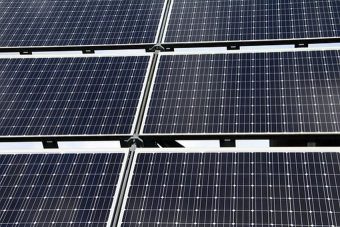
If the United States wants to kick its coal habit, it will need to install a lot more solar power. That raises an important question: Where should all those panels reside?
They could always go live on a farm upstate.
Increasingly, solar companies are working with farmers to install solar panels on their land. Photovoltaic arrays are decidedly low-impact, meaning farmers can continue to raise livestock or grow crops on land covered in solar panels.
Many farmers are turning to solar to cut electricity costs. A lemon and avocado grower in California relies on two photovoltaic arrays to save the company half a million dollars a year. Smaller outfits are using solar panels locally to power electric fences, wells, irrigation systems and other equipment. This helps farmers save money on the cost of building power lines to bring electricity to remote parts of their farms. Nationally, around 8,000 farms generate solar power onsite.
Many are leasing their fields to solar developers in need of flat land clear of trees and other obstructions. This practice has become so popular that the Solar Energy Industries Association published a guide for landowners. Recently, former president Jimmy Carter got in on the act. He set up a community solar array on his Georgia peanut farm nearly 40 years after he installed solar panels at the White House.
In some parts of the South, solar arrays have proved more lucrative to farmers than cash crops like cotton, soybeans and peanuts, which have seen falling prices in recent years. In North Carolina, solar companies pay rents up to $1,400 an acre, which is far more than what most farmers could earn from planting crops or raising livestock.
“There is not a single crop that we could have grown on that land that would generate the income that we get from the solar farm,” Dawson Singletary, a North Carolina tobacco grower, told Bloomberg. Singletary leased part of his land to a local solar developer. He says the income has helped him keep his farm.
Just as solar can be a boon to farming operations, farmers can help keep solar arrays online. A Texas solar firm contracted a breeder to deploy dozens of sheep to mow the grass at at an installation near San Antonio. The panels generate power and provide shade to the sheep, and the sheep keep the grass from growing so tall it obscures the panel. Sheep are particularly well-suited to this task because, unlike goats, they won’t chew on cables or climb atop the panels.
A UK solar firm simply made the land beneath its projects available for grazing. “I am very happy to be able to continue grazing my livestock within the same fields amongst the rows of panels,” said one sheep farmer of an installation in Cornwall. “My sheep keep the site looking fantastic and prevent any overgrowth shading of the panels.” The company also planted wildflowers around the installation to support bees.
Others have done the same. A Minnesota honey producer installed more than a dozen hives at a nearby solar array and planted wildflowers and other plants favored by pollinators under the panels. Rob Davis of the clean-energy advocacy group Fresh Energy persuaded the beekeepers to set up the hives at the installation.
As Davis told National Geographic, “We realized that rural Minnesota, and rural areas of the country, needed to be able to see that they would benefit from this transition to clean energy.”
Source: cleantechnica.com





